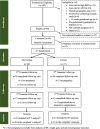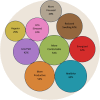The sedentary behavior reduction in pregnancy intervention (SPRING) pilot and feasibility randomized trial
- PMID: 38605328
- PMCID: PMC11007988
- DOI: 10.1186/s12884-024-06474-3
The sedentary behavior reduction in pregnancy intervention (SPRING) pilot and feasibility randomized trial
Abstract
Pregnant individuals rarely achieve moderate-to-vigorous intensity physical activity recommendations.Purpose The sedentary behavior reduction in pregnancy intervention (SPRING) pilot and feasibility randomized trial aimed to demonstrate feasibility, acceptability, and initial efficacy of a lower intensity intervention targeting reduced sedentary behavior and increased standing and steps.Methods First trimester pregnant individuals at risk for high sedentary behavior and adverse pregnancy outcomes (APO) were randomized 2:1 to a multi-component sedentary behavior reduction intervention or no-contact control. Intervention components included biweekly remote health coaching, wearable activity monitor, height-adjustable workstation, and a private Facebook group. Evidence-based behavioral targets included sedentary time < 9 h/day, increasing standing by 2-3 h/day, and ≥ 7500 steps/day. Participants completed all-remote assessments (baseline, second trimester, third trimester) of sedentary behavior and activity (thigh-worn activPAL) along with exploratory pregnancy health outcomes abstracted from medical records. Intervention effects vs. control were evaluated using generalized mixed models and an intention-to-treat approach. Intervention participants also provided feedback on perceived benefits and acceptability.Results Participants (34 intervention; 17 control) had mean age 32 years, were 83% White, with mean pre-pregnancy BMI 28 kg/m2. Retention was high (90% and 83% at second and third trimester follow-up visits). Intervention participants decreased sedentary time (-0.84 h/day, p = 0.019) and increased standing (+0.77 h/day, p = 0.003), but did not increase steps/day (+710, p = 0.257) compared to controls. Intervention participants reported many perceived benefits and identified the wearable, height-adjustable workstation, and behavioral lessons as most useful.Conclusion For pregnant individuals at risk for high sedentary behavior and APOs, a sedentary behavior reduction intervention is feasible, acceptable, and may offer a viable alternative to more intense physical activity recommendations during pregnancy. Further testing in a fully powered clinical trial is warranted.Trial registration NCT05093842 on clinicaltrials.gov.
Keywords: Acceptability; Health coaching; Multi-level intervention; Thigh-worn accelerometer.
© 2024. The Author(s).
Conflict of interest statement
The authors declare no competing interests.
Figures



Similar articles
-
Rationale, Design, and Methods for the Sedentary Behavior Reduction in Pregnancy Intervention (SPRING): Protocol for a Pilot and Feasibility Randomized Controlled Trial.JMIR Res Protoc. 2023 Jun 14;12:e48228. doi: 10.2196/48228. JMIR Res Protoc. 2023. PMID: 37314845 Free PMC article.
-
Feasibility, acceptability, and preliminary efficacy of a single-arm, remotely-delivered health coaching intervention to increase physical activity and reduce sedentary behavior during pregnancy.BMC Pregnancy Childbirth. 2022 Oct 2;22(1):740. doi: 10.1186/s12884-022-05073-4. BMC Pregnancy Childbirth. 2022. PMID: 36184599 Free PMC article.
-
A Home-Based Mobile Health Intervention to Replace Sedentary Time With Light Physical Activity in Older Cancer Survivors: Randomized Controlled Pilot Trial.JMIR Cancer. 2021 Apr 13;7(2):e18819. doi: 10.2196/18819. JMIR Cancer. 2021. PMID: 33847588 Free PMC article.
-
Workplace interventions for increasing standing or walking for decreasing musculoskeletal symptoms in sedentary workers.Cochrane Database Syst Rev. 2019 Nov 17;2019(11):CD012487. doi: 10.1002/14651858.CD012487.pub2. Cochrane Database Syst Rev. 2019. PMID: 31742666 Free PMC article.
-
Stand When You Can: development and pilot testing of an intervention to reduce sedentary time in assisted living.BMC Geriatr. 2020 Aug 6;20(1):277. doi: 10.1186/s12877-020-01647-z. BMC Geriatr. 2020. PMID: 32762644 Free PMC article. Review.
Cited by
-
Influence of a Sedentary Behavior Intervention on Mood, Sleep, and Quality of Life Outcomes During Pregnancy: The SPRING Study.Womens Health Rep (New Rochelle). 2025 Mar 25;6(1):305-314. doi: 10.1089/whr.2024.0176. eCollection 2025. Womens Health Rep (New Rochelle). 2025. PMID: 40308370 Free PMC article.
References
-
- Mosca L, Benjamin EJ, Berra K, Bezanson JL, Dolor RJ, Lloyd-Jones DM, et al. Effectiveness-based guidelines for the prevention of cardiovascular disease in women–2011 update: a guideline from the American Heart Association. J Am Coll Cardiol. 2011;57(12):1404–1423. doi: 10.1016/j.jacc.2011.02.005. - DOI - PMC - PubMed

